Chapter: 12th Physics : Electrostatics
Electric field due to a dipole
Electric field due to a dipole
Case (i) Electric field due to an electric dipole at points on the axial line
Consider an electric
dipole placed on the x-axis as shown in Figure 1.17. A point C is located at a
distance of r from the midpoint O of the dipole along the axial line.
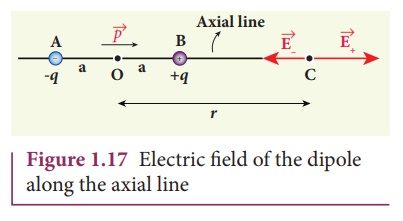
The electric field at a
point C due to +q is

Since the electric
dipole moment vector ![]() is from –q to +q and is directed
along BC, the above equation is rewritten as
is from –q to +q and is directed
along BC, the above equation is rewritten as

where p ^ is the electric dipole
moment unit vector from –q to +q.
The electric field at a
point C due to –q is

Since +q is located
closer to the point C than –q, ![]() + is stronger than
+ is stronger than ![]() - . Therefore, the length
of the
- . Therefore, the length
of the ![]() + vector is drawn larger than that of
+ vector is drawn larger than that of ![]() - vector.
- vector.
The total electric field
at point C is calculated using the superposition principle of the electric
field.
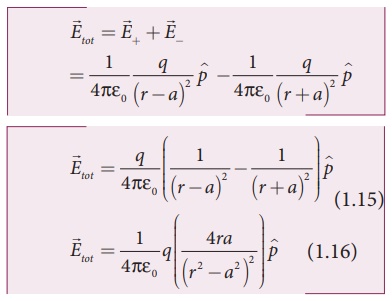
Note that the total
electric field is along ![]() + , since +q is closer to C than –q.
+ , since +q is closer to C than –q.
The direction of ![]() tot
is shown in Figure 1.18.
tot
is shown in Figure 1.18.
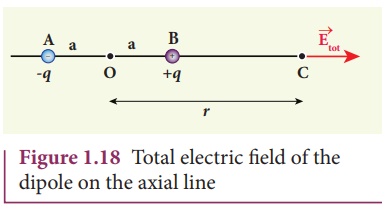
If the point C is very
far away from the dipole then (r >> a). Under this limit the term ( r2 − a2 )2 ≈ r4 .
Substituting this into equation (1.16), we get
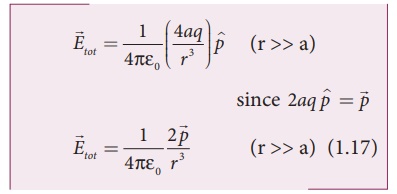
If the point C is chosen
on the left side of the dipole, the total electric field is still in the
direction of ![]() . We infer this result by examining the
electric field lines of the dipole shown in Figure 1.16(b).
. We infer this result by examining the
electric field lines of the dipole shown in Figure 1.16(b). ![]()
![]()
Case (ii) Electric field due to an electric dipole at a point on the equatorial plane
Consider a point C at a
distance r from the midpoint O of the dipole on the equatorial plane as shown
in Figure 1.19.
Since the point C is
equi-distant from +q and –q, the magnitude of the electric fields of +q and –q
are the same. The direction of ![]() + is along BC and the
direction of
+ is along BC and the
direction of ![]() - is along CA.
- is along CA. ![]() + and
+ and ![]() - are resolved into two
components; one component parallel to the dipole axis and the other
perpendicular to it. The perpendicular components |
- are resolved into two
components; one component parallel to the dipole axis and the other
perpendicular to it. The perpendicular components | ![]() +| sinθ and |
+| sinθ and | ![]() -| sinθ are oppositely directed
and cancel each other. The magnitude of the total electric field at point C is
the sum of the parallel components of
-| sinθ are oppositely directed
and cancel each other. The magnitude of the total electric field at point C is
the sum of the parallel components of ![]() + and
+ and ![]() - and its direction is
along -^p as shown in the Figure
1.19.
- and its direction is
along -^p as shown in the Figure
1.19.

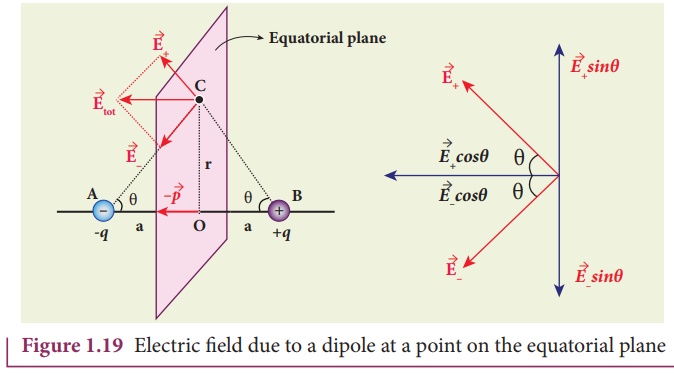
The magnitudes ![]() + and
+ and ![]() - are the same and are
given by
- are the same and are
given by

By substituting equation
(1.19) into equation (1.18), we get

At very large distances
(r>>a), the equation (1.20) becomes

Important inferences
(i) From equations
(1.17) and (1.21), it is inferred that for very large distances, the magnitude
of the electric field at points on the dipole axis is twice the magnitude of
the electric field at points on the equatorial plane. The direction of the
electric field at points on the dipole axis is directed along the direction of
dipole moment vector ![]() but at points on the equatorial
plane it is directed opposite to the dipole moment vector, that is along -
but at points on the equatorial
plane it is directed opposite to the dipole moment vector, that is along -![]() .
.
(ii) At very large
distances, the electric field due to a dipole varies as 1/r3 . Note
that for a point charge, the electric field varies as 1/r2 .
This implies that the electric field due to a dipole at very large distances
goes to zero faster than the electric field due to a point charge. The reason
for this behavior is that at very large distance, the two charges appear to be
close to each other and neutralize each other.
![]()
![]() (iii) The equations
(1.17) and (1.21) are valid only at very large distances (r>>a). Suppose the distance 2a approaches zero and q
approaches infinity such that the product of 2aq = p is finite,
then the dipole is called a point dipole. For such point dipoles, equations
(1.17) and (1.21) are exact and hold true for any r.
(iii) The equations
(1.17) and (1.21) are valid only at very large distances (r>>a). Suppose the distance 2a approaches zero and q
approaches infinity such that the product of 2aq = p is finite,
then the dipole is called a point dipole. For such point dipoles, equations
(1.17) and (1.21) are exact and hold true for any r.
Related Topics